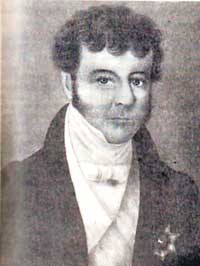Governor
Horton begins era of reforms
"Ceylon is one of the loveliest spots
in the universe, if some of the old Dutch laws were done away,
among which, in my judgement, the chief are the monopoly of
cinnamon, and the compulsory labour of the peasants on the
high roads, and in other species of corvees. The Candian (Kandyan)
provinces, where neither of these exists, seemed to me the
most prosperous parts of the country." These comments
were made in a letter dated April 1, 1826 written by Reginald
Heber, Bishop of Calcutta to the Under Secretary of the War
and the Colonies in the British Government. Five years later,
Sir Robert Wilmot Horton, the Under Secretary, assumed duties
as the Governor of Ceylon. He arrived on October 23, 1831.
 |
| Governor Sir Robert Wilmot Horton |
Just before he was appointed Governor, the
Colebrooke Commission had recommended far reaching reforms
and it was Horton's task to see that these were implemented.
He himself, as a Liberal, took a great interest in social
reform. He was directed to set up an Executive Council of
five and a Legislative Council of 15 as recommended by the
Colebrooke Commission. The Executive Council replaced the
Governor's Council and could debate and vote on all matters
brought before it by the Governor. It could, however, meet
only when summoned by the Governor. The Legislative Council
had nine officials and six unofficial members. The latter
were to be nominated by the Governor to represent the Ceylonese
and the Europeans. Horton was not happy about these representatives
claiming that there wasn't anyone fit to hold such office.
In fact, when the Legislative Council met for the first time
on October 1, 1833, there were only officials present. Later
the unofficial members were appointed.
No more forced labour
On instructions from the Secretary of State for the Colonies,
Governor Horton implemented another recommendation by the
Colebrooke Commission to abolish forced labour. On April 12,
1832, the King issued an order-in-council declaring that,
"none of His Majesty's native or Indian subjects in the
island of Ceylon shall be liable to render any service in
respect of the tenure of land or in respect of his caste or
otherwise, to which His Majesty's other subjects of European
birth and descent are not liable, any law or custom or regulation
to the contrary notwithstanding."
 |
| 'Diving for fishing' - a photograph
in the Ceylon Observer Centenary Supplement |
Other reforms followed. In May 1832 the law
against Moors and Chettiars owning land in Colombo was repealed.
The cinnamon monopoly held by the Government was abolished.
Judicial reforms included the vesting of administration of
justice on the Supreme Court and in district courts. Trial
by jury was extended to the whole island.
In the sphere of education, a Board of Education
was set up in 1834, as recommended by the Commission. The
Colombo Academy (later renamed Royal College) was started
in 1834. The Catholics started an English school with Government
aid.
A significant feature during Horton's tenure
was the huge successes of the pearl fisheries. This enabled
him to record surpluses in the government budget, and so to
undertake road construction.
Governor Horton's administration ended in
1837 and he was succeeded by J. A. Stewart Mackenzie (1837-41).
|
Keppetipola
Dissave arrested
Keppetipola Dissave who took over the leadership
of the rebellion against the British in 1817-18 was arrested
on October 28, 1818 near Nuvara Kalaviya. When the rebellion
started in a remote part of Uva , he was Dissave of Uva and
later decided to join the rebels and assume leadership.
After the rebellion was crushed and he was
arrested, he was court marshalled and convicted. He was beheaded
at Bogambara in Kandy a month later.
|


